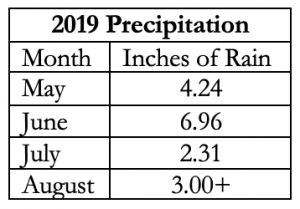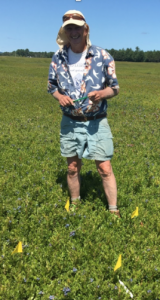Wild Blueberry Newsletter, August 2019

August 2019
Spotted Wing Drosophila Alert: August 9, 2019
David Handley, Vegetable and Small Fruit Specialist; James Dill, Pest Management Specialist; Frank Drummond, Professor of Insect Ecology/Entomology; Christina Howard, Produce Safety Professional
Spotted wing drosophila fruit fly numbers increased this week at nearly all of the berry farm locations that are monitored in Maine. We are seeing similar reports throughout the northeast, indicating that SWD pressure continues to build, and growers with susceptible crops, including blueberries, raspberries, blackberries, and strawberries now need to apply protective sprays or covers to keep fruit from becoming infested with larvae.
Fly counts this week at nearly all sites were above 6 to 10 flies caught in a yeast-baited trap. Larvae will now start appearing in the fruit and populations will continue to build in the coming weeks as more food (fruit) becomes available for the flies. The buildup could be very rapid, especially if conditions remain warm and wet.
In the field, the best way to keep SWD populations from exploding is to clean up any waste fruit from the ground (hard to do in wild blueberry fields). Not allowing rotten or over ripe fruit to stay on the ground will reduce populations. Further, promote dry conditions in the field by practicing good weed management to allow more light and air movement within and between plants. For more recommendations read Factsheet 210, Spotted Wing Drosophila: Pest Biology and IPM Recommendations for Wild Blueberries.
Wild Blueberry Facebook Group! Search for Wild Blueberry Connect under Groups using the Facebook search bar.
Bleuets NB Blueberries (BNBB) invite you to join our private — growers only — group page on Facebook. This is a great opportunity for you to exchange tips and opportunities as a Buy and Sale advertising platform. Join the conversation with producers from PEI, NS, QC and NB.
Crop Update
Lily Calderwood, Wild Blueberry Specialist and David Yarborough, Emeritus Wild Blueberry Specialist
Extremely cold weather in February without adequate snow cover led to a substantial amount of winter kill in which the stems died back killing most of the flower buds impacting the crop. The spring was also very cold and wet which delayed bloom by two weeks.
 Unfortunately, many bee hives had been put out in the field by mid-May when very little forage was available, allowing the hives to decline if they were not fed with sugar-water. Eventually there was good pollination and fruit set but with limited bloom due to the winter injury. Jennifer Lund, State Apiculturist, reports that we had about 50,000 hives in Maine this year, up from 37,200 in 2018.
Unfortunately, many bee hives had been put out in the field by mid-May when very little forage was available, allowing the hives to decline if they were not fed with sugar-water. Eventually there was good pollination and fruit set but with limited bloom due to the winter injury. Jennifer Lund, State Apiculturist, reports that we had about 50,000 hives in Maine this year, up from 37,200 in 2018.
The devastating freeze event last year only produced 50.4 million pounds (half the yield observed in 2014-2016). All of the Canadian provinces except Quebec were also down substantially in 2018, so the total wild crop was 220.4 million pounds in 2018. Several fields were not harvested last year, creating fields that are now cropping for the second year in a row.
Time to put out Mummy Berry Plots

The mummy berries that fall to the ground every August wreak havoc to you every spring. As hard as it is to plan ahead, consider putting out a Mummy Berry Plot. This is an easy thing to do and will tell you when mummy berry cups are up in your own field. You will need to look at the plot about 2 times a week in the spring.
- Collect about 60 to 150 mummy berries (20 to 50 for each mummy berry plot).
Mummies can come from crop fields, from the process line or winnow piles if you have them. Some clones or the edges of fields will have more mummies. There are usually more mummies under plants with a few visible mummies on the stems. If you need to store the mummies, keep them in a paper bag in the shade. - Find three locations in next year’s crop field. Locations in flat areas among the plants work best. Choose areas (3” by 3”) that look like they have damp soil most of the time AND will be easy for you to access next spring. If you have different exposures, soil types or large shaded areas in your field you may want to place your mummy berry plots around your field to get the full range of when the mummy berries develop. The areas should not be on slopes where the mummy berries will be washed away, in hollows where they will be water-logged or in areas with lots of frost-heaves.
- Place the mummies in the plots. Scrape off the leaf litter to the side, then scrape off the top 1/4” of hard packed soil and put aside. Place about 20 to 50 mummy berries on the surface of the soil and press the mummy berries firmly into the soil (with your fingers or step on them). Cover the mummy berries with a small amount of dirt (1/4”) and press them firmly down again. You should just have the mummy berries covered with soil. Replace the leaf litter over the mummy berries again. Stake or flag the plots on either side so you can locate them in the spring. Two stakes or flags makes it much easier to figure out where to look in the spring.
Upcoming Events
Western Maine Wild Blueberry Growers Meeting
September 24, 2019
10:00 am – 12:00 noon
47 Cook Road, Otisfield, Maine (Brad LaRoche’s Farm)
Sincerely,
Extension Wild Blueberry Specialist
University of Maine, Orono

